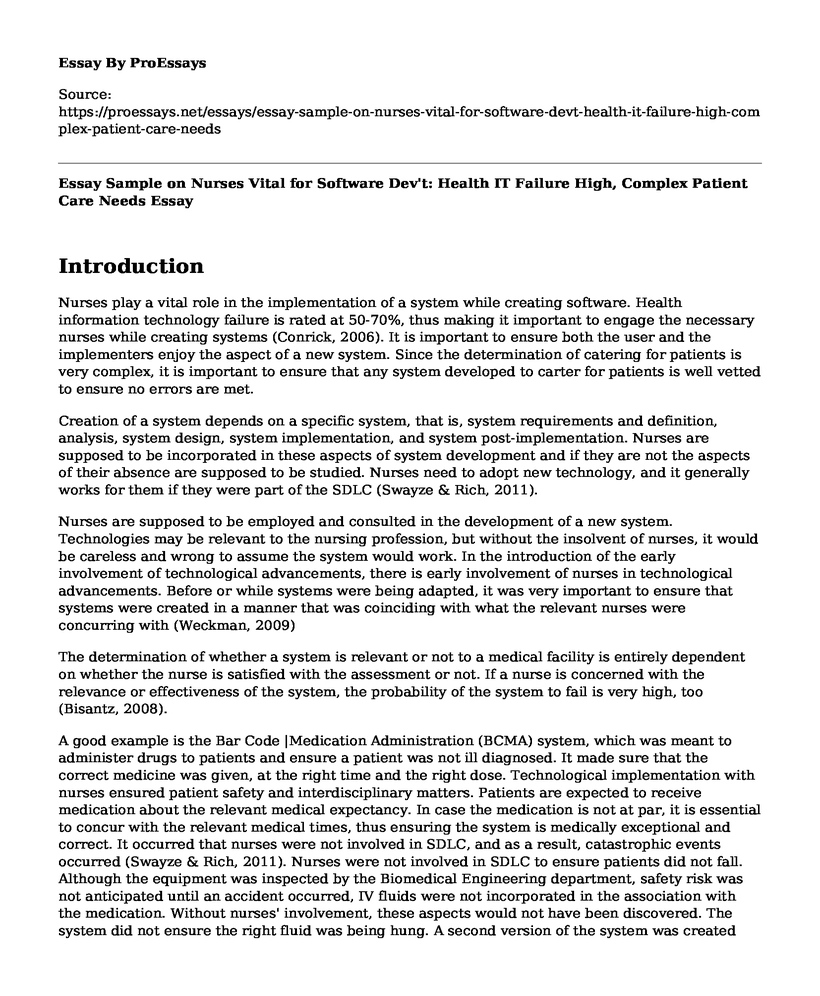Introduction
Nurses play a vital role in the implementation of a system while creating software. Health information technology failure is rated at 50-70%, thus making it important to engage the necessary nurses while creating systems (Conrick, 2006). It is important to ensure both the user and the implementers enjoy the aspect of a new system. Since the determination of catering for patients is very complex, it is important to ensure that any system developed to carter for patients is well vetted to ensure no errors are met.
Creation of a system depends on a specific system, that is, system requirements and definition, analysis, system design, system implementation, and system post-implementation. Nurses are supposed to be incorporated in these aspects of system development and if they are not the aspects of their absence are supposed to be studied. Nurses need to adopt new technology, and it generally works for them if they were part of the SDLC (Swayze & Rich, 2011).
Nurses are supposed to be employed and consulted in the development of a new system. Technologies may be relevant to the nursing profession, but without the insolvent of nurses, it would be careless and wrong to assume the system would work. In the introduction of the early involvement of technological advancements, there is early involvement of nurses in technological advancements. Before or while systems were being adapted, it was very important to ensure that systems were created in a manner that was coinciding with what the relevant nurses were concurring with (Weckman, 2009)
The determination of whether a system is relevant or not to a medical facility is entirely dependent on whether the nurse is satisfied with the assessment or not. If a nurse is concerned with the relevance or effectiveness of the system, the probability of the system to fail is very high, too (Bisantz, 2008).
A good example is the Bar Code |Medication Administration (BCMA) system, which was meant to administer drugs to patients and ensure a patient was not ill diagnosed. It made sure that the correct medicine was given, at the right time and the right dose. Technological implementation with nurses ensured patient safety and interdisciplinary matters. Patients are expected to receive medication about the relevant medical expectancy. In case the medication is not at par, it is essential to concur with the relevant medical times, thus ensuring the system is medically exceptional and correct. It occurred that nurses were not involved in SDLC, and as a result, catastrophic events occurred (Swayze & Rich, 2011). Nurses were not involved in SDLC to ensure patients did not fall. Although the equipment was inspected by the Biomedical Engineering department, safety risk was not anticipated until an accident occurred, IV fluids were not incorporated in the association with the medication. Without nurses' involvement, these aspects would not have been discovered. The system did not ensure the right fluid was being hung. A second version of the system was created discerning normal saline from normal saline with potassium. Equipment made while nurses were involved may also be simpler and safer since there was the avoidance of technology-related stress (Lavin, Harper & Barr, 2015). It is therefore right to conclude that system development of healthcare systems is not only dependent on the programmers or patients but also on the nurses to ensure the success of the system.
References
Bisantz, A. (2008). Cognitive Engineering Applications in Healthcare. National Academy of Engineering. 38(4). Retrieved from http:/www.nae.edu/Pulications/The bridge/Archives/V-38 4Fronteersofengeneering/CognitiveengeneeringapplicationsinHealthcare.aspx
Conrick, M. (2006). Health informatics. Cengage Learning Australia.
Lavin, M. A., Harper, E., & Barr, N. (2015). Health information technology, patient safety, and professional nursing care documentation in acute care settings. Online J Issues Nurs, 20(2). Retrieved from https://www.ncbi.nlm.nih.gov/pubmed/26882425
Swayze, S., & Rich, S. (2011). Promoting the safe use of medical devices. OJIN: The Online Journal of Issues in Nursing, 17(1), 9. Retrieved from http://ojin.nursingworld.org/MainMenuCategories/ANAMarketplace/ANAPeriodicals/OJIN/TableofContents/Vol-17-2012/No1-Jan-2012/Articles-Previous-Topics/Safe-Use-of-Devices.html
Weckman, H., & Janzen, S. (2009). The critical nature of early nursing involvement in introducing new technologies. OJIN: The Online Journal of Issues in Nursing, 14(2). Retrieved from http://ojin.nursingworld.org/MainMenuCategories/ANAMarketplace/ANAPeriodicals/OJIN/TableofContents/Vol142009/No2May09/Nursing-Involvement-and-Technology.html
Cite this page
Essay Sample on Nurses Vital for Software Dev't: Health IT Failure High, Complex Patient Care Needs. (2023, Jan 30). Retrieved from https://proessays.net/essays/essay-sample-on-nurses-vital-for-software-devt-health-it-failure-high-complex-patient-care-needs
If you are the original author of this essay and no longer wish to have it published on the ProEssays website, please click below to request its removal:
- Essay Example on Influenza
- Term Paper Example on Public Health: Orem's Self-care Model for Patients with Diabetes
- Outline for Argumentative Essay: Vaccines Are Linked With Autism
- Services for Dementia in the Elderly Essay
- Essay Sample on Elderly Security: CCTV in Care Homes
- Nurse-Sensitive Indicators: Assessing Quality of Care - Essay Sample
- Innovating SMEs in China: Unlocking Competitive Advantage & Sustainable Growth - Essay Sample







